I’m new to stock markets. Which is the best stock investing course for beginners?
Hey there! Congratulations ☺
The fact that you’re reading this page
means that you’re getting ready to
take action for your
financial
future.
We
know this is a huge step for you to take and
we’re right here to guide you on this
journey.
So,
which is our best stock investing course for
beginners? Let’s begin by answering these
questions on your mind right now.
1. What stock to buy?
As a beginner, you may have fears of investing in the wrong company and burning your hard-earned savings. Therefore it is important to know which are the great companies that will soar in share price in the long run and grow your capital multi-fold.
In Overstone ETF Consult ™, you will learn how to analyse and study the financial strength of a company (we call this Fundamental Analysis). At the end of the course, you will be able to calculate the true value of any stock and know whether it is worth investing in.
2. How many shares to buy?
Once you know which company to buy, you must know how much money to invest in it. Many newbie investors make the mistake of placing all their eggs in one basket and risk wiping out their account when things go awry.
In Whale Investor™, you will learn how to diversify your portfolio and allocate your capital so that you keep your overall risk well-balanced while having good growth potential.
3. When to buy and sell my stocks?
You may have heard the concept of “Value Investing”, where investors buy stocks when they are undervalued (cheaper than their intrinsic value). However, especially during a market downturn, investors often find that “cheap gets cheaper”.
In Whale Investor™, you will learn Adam Khoo’s trademark Value Momentum Investing™ (VMI™) strategy, where you will know when to enter and exit stocks at good prices so that you secure more profits than the typical value investor. Whale Investor™ is the first and only course in the world that teaches this strategy, so you’ll not find this anywhere else!
The Importance of Investing with the Right Mindset
Overstone ETF Consult ™ covers a highly important aspect of investing that most courses don’t teach you—your PSYCHOLOGY. When you first enter the markets, it’ll be easy to fall prey to emotions such as greed and fear, causing you to make irrational decisions like panic selling or over-buying.
In the course, we dedicate one whole lesson to teach you how to manage your emotional states during investing so that you can make consistent profits.
How much capital do I need to start?
Finding the Right Amount to Start With
This depends on your financial situation and what amount you’re comfortable with. Generally, we suggest students to start with an amount you “can afford to lose”. We’re not saying that you will lose money—you will make money when you apply the course strategies properly.
But over the years we’ve found that students who go in with all their life savings often put too much pressure on having to “make back my course fees”, having to “grow so-and-so amount by end of the year”, etc. This deeply affects their investor psychology and causes them to make irrational buy/sell decisions that sabotage their profits.
Before you start investing, make sure you have at least 6 months’ worth of living expenses put aside in case of unforeseen circumstances like retrenchment or hospitalisation. Never touch your emergency funds for investing!
As a rule of thumb, we find USD 5,000 – 10,000 to be a good amount to start with. You can gradually increase your portfolio size after you become more familiar with the strategies.
You may also want to consider what kind of returns are meaningful to you. Let’s say your investments bring you 10% gains in a year. If you had started with a USD 5,000 capital, that would mean a USD 500 gain after one year. Find that comfortable amount that motivates you to take action, while not being overtaxing on your finances.
Can I Start Investing If I Have Limited Capital
If you don't have a lot of capital, you can still start investing. You can start small by investing 10% of your salary every month in relatively safer areas like ETFs. This money will eventually compound into a sizeable amount when you put in the discipline to hold for the long term.
Alternatively, some brokers also offer fractional shares investing, so you can own part of an expensive stock such as Amazon (AMZN) even if you can’t afford the full share of ~$2,000.
What kind of returns will I see?
This depends on what kind of portfolio you choose to build (your risk appetite); whether you go for “safer” stocks like ETFs that historically average about 8% a year, or more aggressive growth stocks that come with relatively higher risk.
In Overstone ETF Consult ™, we cover strategies for all risk profiles. Generally, by applying Whale Investor™ course strategies, students can expect returns of about 10 – 20% per year given a 5-year period.
As investors, we measure returns by percentage (%), not by absolute numbers. This is because how much absolute dollars you make depends on how much capital you put in.
For example, Alex and Betty hold the exact same portfolio of stocks. But Alex starts with USD 10,000 while Betty starts with USD 50,000. At the end of one year, the portfolio has grown 10%.
In absolute figures, Alex would have earned USD 1,000 while Betty earned USD 5,000. Now, does that make Betty a more successful investor? No, because they both grew their investments by 10%.
As investors, we measure returns by year, not months or days. This is because our goal is to grow our capital in the long-term (beating inflation and measly fixed deposit interest rates).
We want to buy fundamentally strong companies and hold them for the long term (5 to 10 years or more), and we don’t think about selling them for quick profits.
In the short-term, even great companies’ stock price may fall temporarily due to bad news, so it is not meaningful to measure profits by months or days.
How soon will I be able to start investing?
This depends on your learning pace and readiness. Our Whale Investor™ course contains 16+ hours of video lessons, so some students can complete it in as fast as a few days. Students who can grasp the course strategy fully may be able to start investing in lower-risk stocks like ETFs within the next few weeks.
Should I practise on a demo account first?
This depends on your personality. If you’re someone who needs a lot of practice before you’re confident to make decisions, it is good to start with a demo account.
At the same time, we do have students who shared with us that starting small with real money gives them more motivation to manage their account. This is because when real money is at stake, people tend to take things more seriously and are more cautious when placing orders. Investing with real money also lets you experience the flurry of emotions you may get from watching the market movement, and helps you learn from your mistakes.
Whichever way you choose, practise and start small. Never go in with a get-rich-quick mindset and throw in all your savings!
How much time do I need to spend?
For investing, you don’t have to monitor the markets every day. Minimally, we look at it once every quarter, because this is when companies publish their earnings report (which may change your calculation of their intrinsic value). This helps us decide whether to rebalance our portfolio.
In fact, investors don’t have to obsess over day-to-day market movements, because we are confident that the stock will rise over the long term and don’t mind what happens in the short term. We can even “buy and close our eyes”.
That said, when you first start, you will need to spend time to scan the market for good quality companies and study their financial reports to determine whether to invest. As a beginner, this may take you a few hours a week. But once you become familiar with where to find the key figures and what to look out for, it can be as fast as 30 minutes.
What if I can’t grasp the concepts?
After mentoring over 10,000 beginner investors from 145 countries, we understand that every person has a different learning pace. Some students can understand the lessons in one sitting, while others need more time.
The beauty of our online course is you can watch it as many times as you like, from the comfort of your own home. If you find a topic to be challenging, you can repeat the video and revise until you absorb it fully.
Once you enrol in our course, you’re given 24/7 online access so you can study the course any time, anywhere, at your own pace.
What if I have questions? Is there someone I can ask?
Absolutely. We recognise that newbie investors like you need all the support, guidance and help to gain the confidence to get started. You may have encountered other courses out there that offer limited support or the trainer disappears after collecting the course fees.
Will you teach me how to choose a broker?
Yes! In Lesson 11 of Overstone ETF Consult ™, you will learn how to choose a reputable and cost-saving broker, as well as other important criteria to look at.
We will also walk you through how to place orders using the broker platform.
Is stock investing safe?
Every form of investment comes with risk, that’s why you must learn how to manage it. Investing is like driving a car; if you step on the pedal without learning how to drive, you can get hurt pretty badly. At the same time, if you practise and acquire the skill, the result is highly rewarding.
In fact it is more “dangerous” to do nothing and leave your savings in the bank, because your money will gradually lose its value against inflation.
At Overstone ETF Consult ™, we teach you proven strategies to make consistent long-term profits from the stock market and avoid making unsound decisions.
Does your course really work? Can you show me your results?
Yep! We understand that you want to learn from a mentor with a track record that you can trust. Our investment mentor Adam Khoo has been investing for over 27 years and studies the markets for at least 3 hours every day.
There are many “gurus” out there who teach “sure-win” strategies, but they spend more time teaching than actually trading. For Adam, he is 100% invested in his own strategy and stock picks. Here’s a screenshot of two of his personal investing accounts (he has a few) with a combined investment of over USD 1 million.
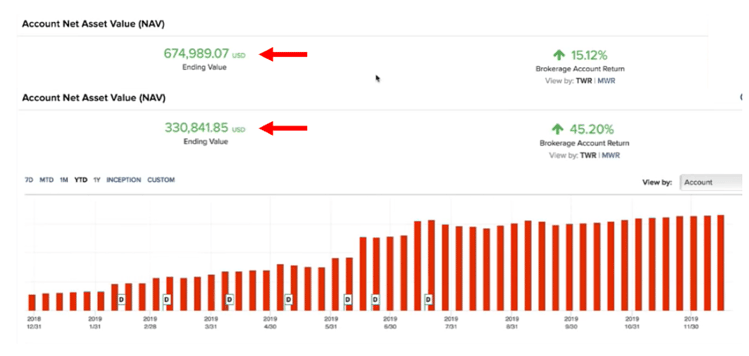
Adam also beats the S&P 500 index every year with his VMI™ strategy. (This is the same strategy you will learn in Overstone ETF Consult ™.) Here’s a snapshot of his latest portfolio performance where he beat the index and achieved +44% returns in 2019.
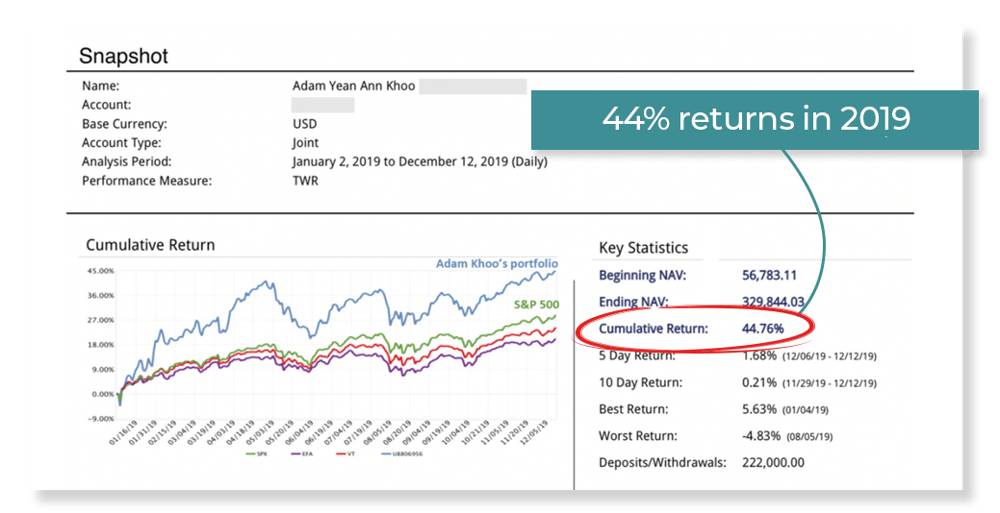
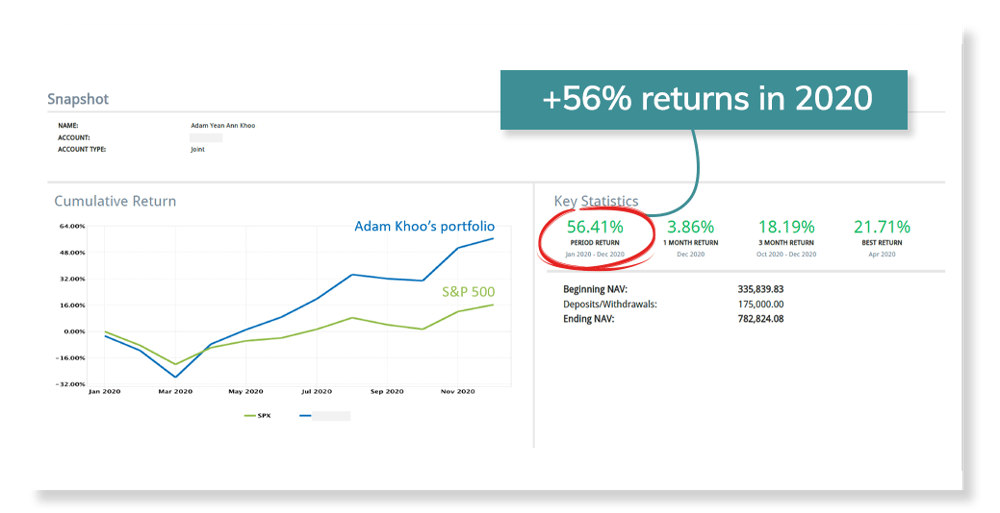
At the same time, what’s more important is whether the mentor can successfully guide his students to achieve the same results. Check out these real-life results achieved by our students. Some even went on to beat Adam in terms of percentage gains!
Read the Rave Reviews from Our Whale Investor™ Course Students
Enrol in the investing course
that brings you real
returns. See
the results our students
achieved after attending
the
Value
Momentum Investing™ course by
Adam Khoo.
“Achieved Index-Beating Investment Returns”
See how these investors
outperformed the S&P 500 by
picking
winning
stocks
with Adam Khoo’s VMI
strategy!
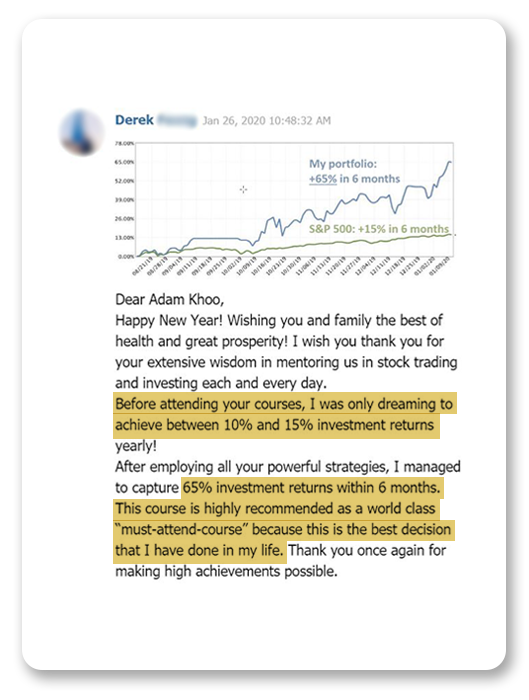
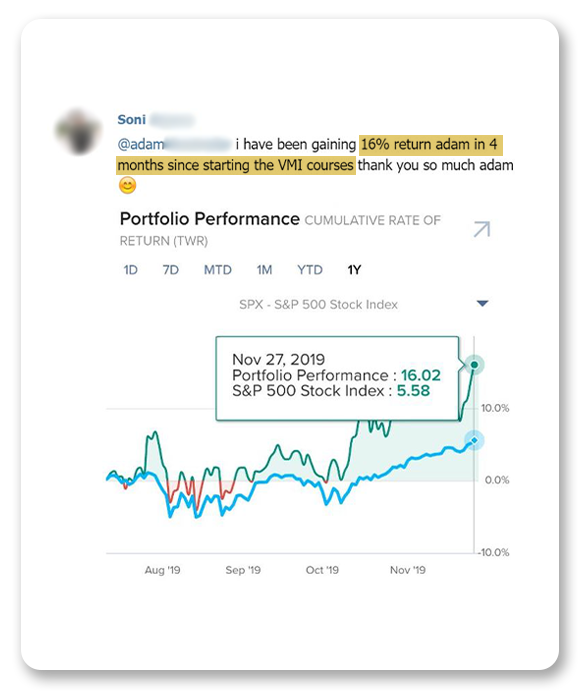
“From Clueless and Losing Money to Getting Strong Positive Returns”
These investors turned their portfolio
losses into solid gains after
learning
Adam Khoo’s VMI
strategy. If they can do it, so can
you!
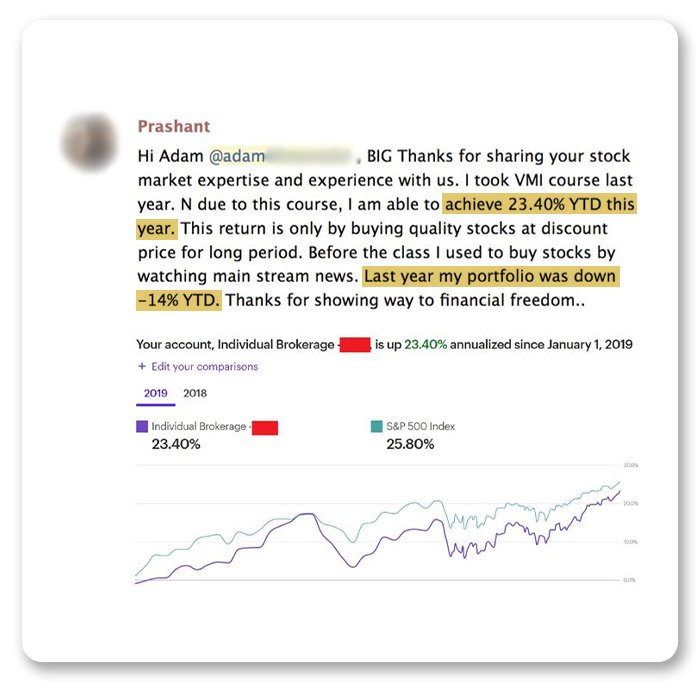
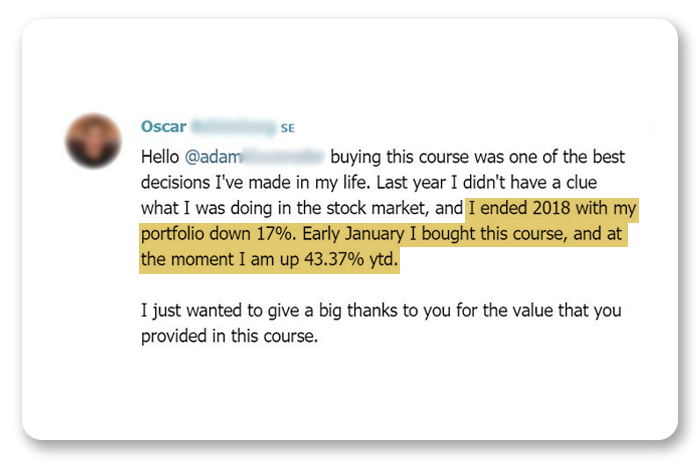
“Achieved Profitable Results Within Months After the Course”
These investors earned back their course fee by practising and applying what they learnt in the course.
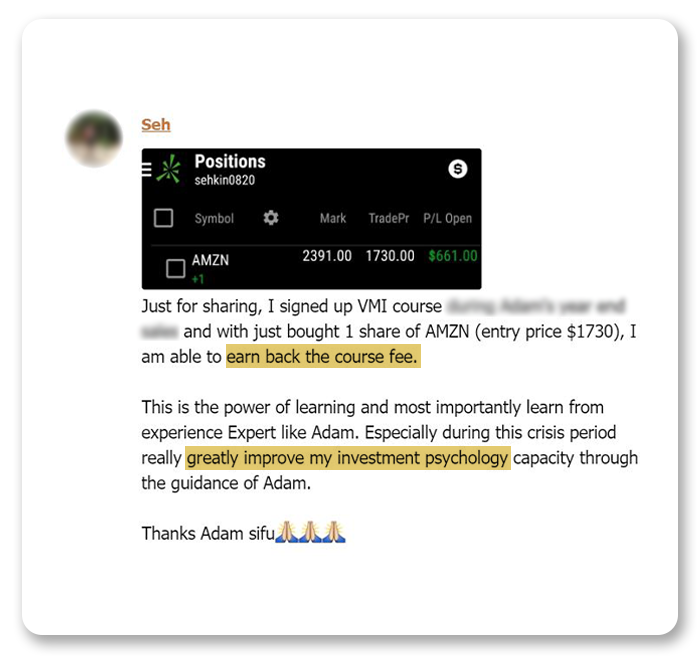
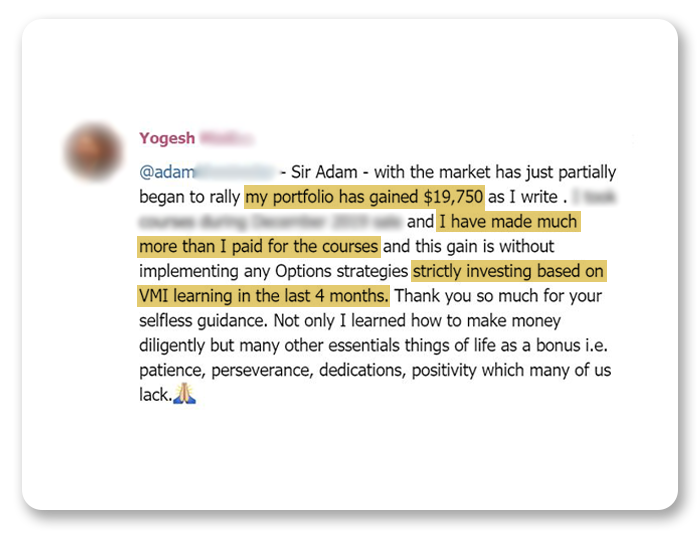
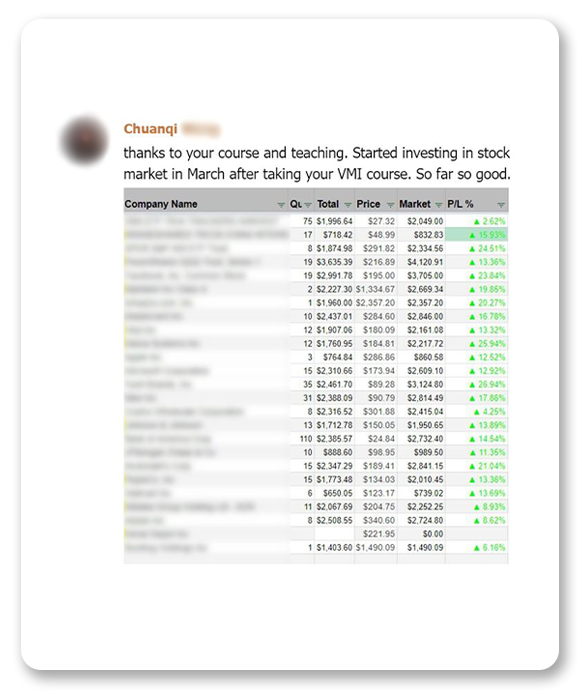
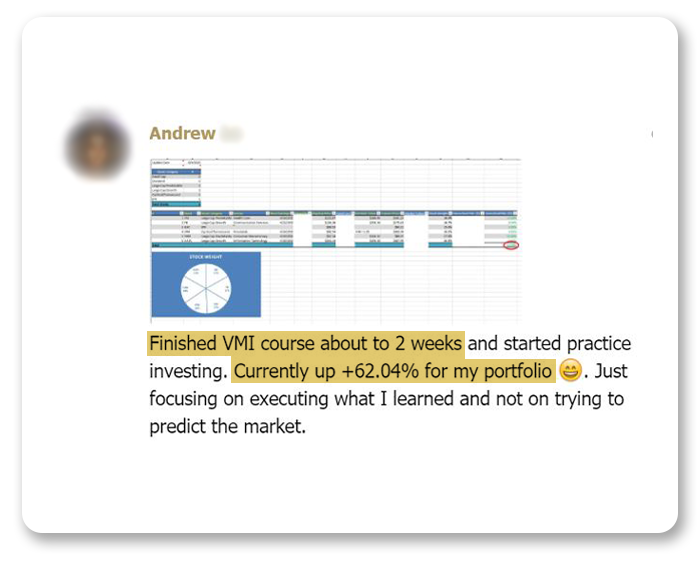
In conclusion, if you’re serious about kickstarting your investing journey, Whale Investor™ is the best course for you.
Overstone ETF Consult ™ cuts short your learning curve by equipping you with the mindset, knowledge, strategies, tools and support to succeed in stock investing.
We know that taking this huge step can be daunting for you, so we’re with you every step of the way. Trust us that years from now, you will look at your portfolio and smile, knowing that this is one of the best decisions you’ve made for your financial future.
Risk
Disclosure
Trading or investing whether on margin or
otherwise carries a high level of risk, and may not be suitable for all
persons. Leverage can work against you as well as for you. Before
deciding to trade or invest you should carefully consider your
investment objectives, level of experience, and ability to tolerate
risk. The possibility exists that you could sustain a loss of some or
all of your initial investment or even more than your initial investment
and therefore you should not invest money that you cannot afford to
lose. You should be aware of all the risks associated with trading and
investing, and seek advice from an independent financial advisor if you
have any doubts. Past performance is not necessarily indicative of
future results.